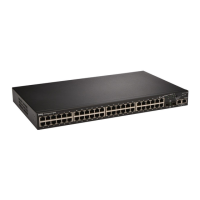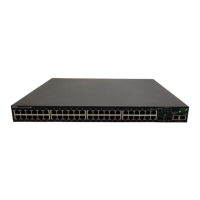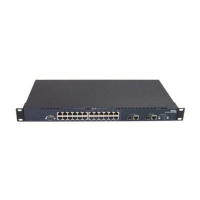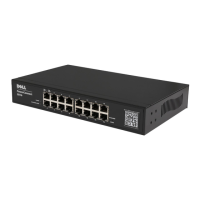
Do you have a question about the Dell PowerConnect 3524P and is the answer not in the manual?
| MAC address table | 8000 entries |
|---|---|
| Maximum data transfer rate | 0.1 Gbit/s |
| Supported data transfer rates | 10/100 Mbps |
| 10G support | - |
| Number of VLANs | 256 |
| Flow control support | Yes |
| Networking standards | IEEE 802.1D, IEEE 802.1p, IEEE 802.1Q, IEEE 802.1s, IEEE 802.1w, IEEE 802.3ad |
| Dimensions (WxDxH) | 440 x 387 x 43.2 mm |
| Power requirements | 100-240VAC, 50-60Hz |
| Networking features | Gigabit Ethernet, Fast Ethernet |
| Authentication method | RADIUS, TACACS+ |
| Connectivity technology | Wired |
| Switch type | Managed |
| Switch layer | L2 |
| Data link protocols | Ethernet |
| Supported network protocols | HTTP, HTTPS/SSL, SSH |
| Power connector | DC-in jack |
| SFP/SFP+ slots quantity | 2 |
| Basic switching RJ-45 Ethernet ports quantity | 24 |
| Product color | Black |
| Storage temperature (T-T) | -20 - 70 °C |
| Operating temperature (T-T) | 0 - 45 °C |
| Storage relative humidity (H-H) | 10 - 95 % |
| Operating relative humidity (H-H) | 10 - 90 % |
| Weight | 8000 g |
|---|
Provides an overview of the PowerConnect 3524/3548 and 3524P/3548P device types.
Explains the concept of switch stacking, management, and supported configurations.
Describes the various features supported by the PowerConnect systems.
Details the ports available on the PowerConnect 3524 and 3548 front and back panels.
Provides the physical dimensions for PoE and non-PoE models.
Explains the meaning of the various LEDs on the front panel of the devices.
Outlines the requirements for preparing the installation site for the devices.
Provides instructions for unpacking the device and verifying package contents.
Details instructions for mounting the device in a rack, on a flat surface, or on a wall.
Explains how to connect a terminal for device configuration and management.
Covers the process of installing multiple switches in a stack configuration.
Guides the user through the initial steps of powering on and configuring the device.
Details the process of initial device configuration using the Setup Wizard or CLI.
Covers dynamic IP address allocation and security management.
Describes the default settings for auto-negotiation and port configuration.
Provides steps to start and log in to the Dell OpenManage Switch Administrator.
Explains the components of the Switch Administrator home page interface.
Details how to access and manage the device using the Command Line Interface (CLI).
Covers viewing and configuring system asset information and general device settings.
Provides information on configuring and viewing system logs and parameters.
Explains how to assign interface and default gateway IP addresses.
Details how to perform virtual cable tests on copper and fiber optic cables.
Covers setting network security via access control lists and locked ports.
Explains Access Control Lists (ACLs) for classifying and filtering traffic.
Details how to enable DHCP Snooping for network security.
Covers port functionality, including storm control and port mirroring.
Explains how MAC and IP addresses are stored and managed.
Details Spanning Tree Protocol (STP) for preventing network loops.
Provides information on configuring VLANs, membership, and ports.
Covers configuring Voice VLANs for VoIP traffic prioritization.
Explains how to optimize port usage by linking ports into Link Aggregated Groups (LAGs).
Details multicast forwarding capabilities and IGMP snooping.
Provides links for displaying statistics in a table format.
Allows network managers to view network information from a remote location.
Contains links for displaying statistics in a chart form.
Explains how to implement QoS and priority queuing within a network.
Provides fields for enabling/disabling QoS and selecting Trust mode.
Details deactivating Trust mode and setting default CoS for untagged packets.
Contains fields for classifying CoS settings to traffic queues.
Provides fields for defining egress queues to specific DSCP fields.











